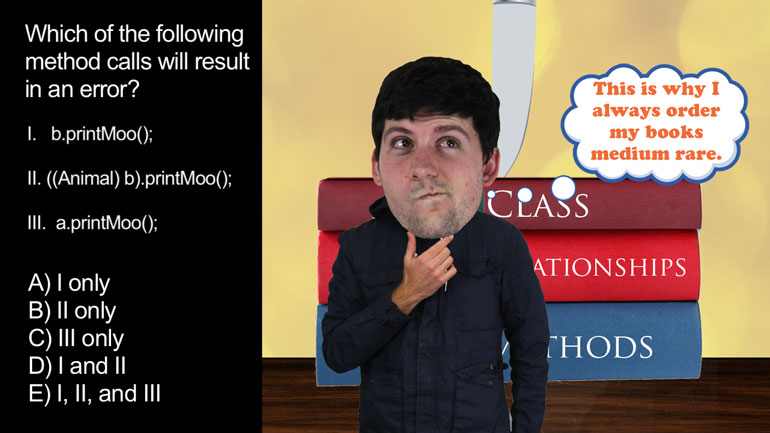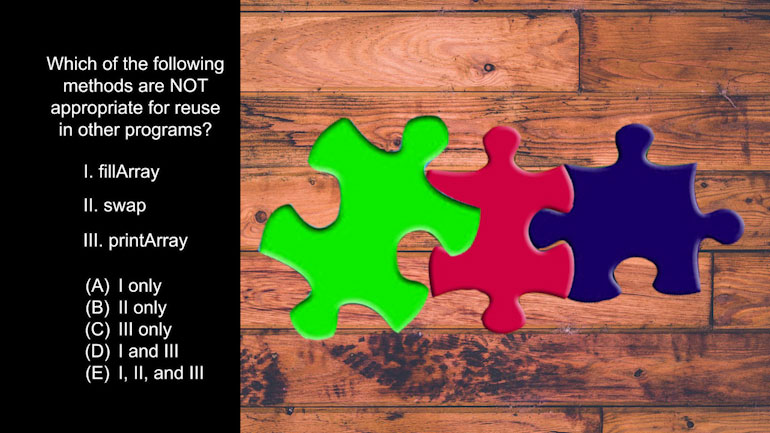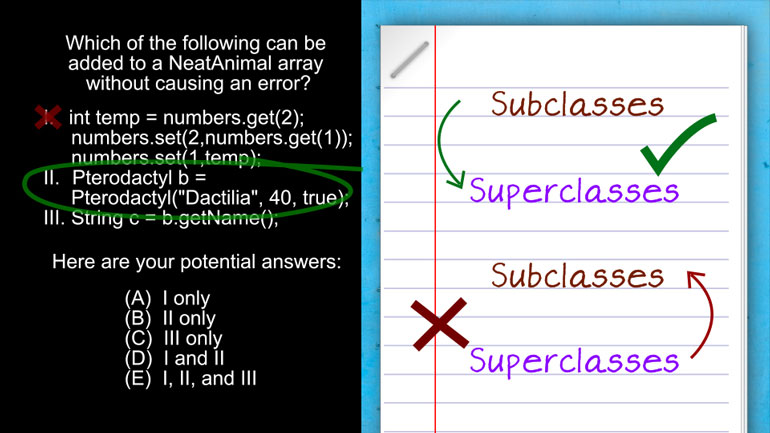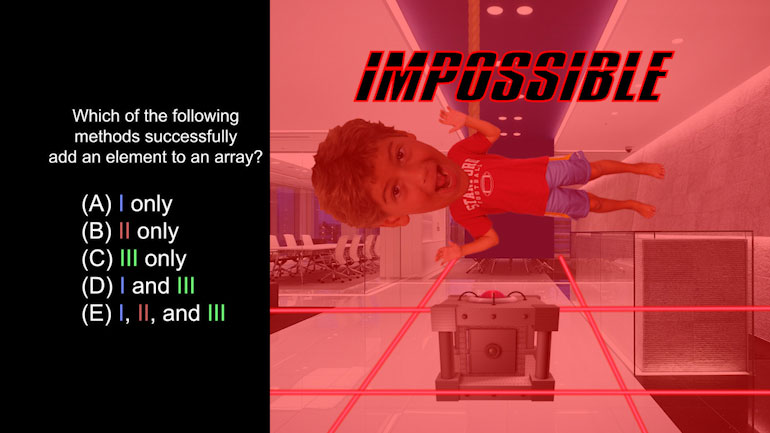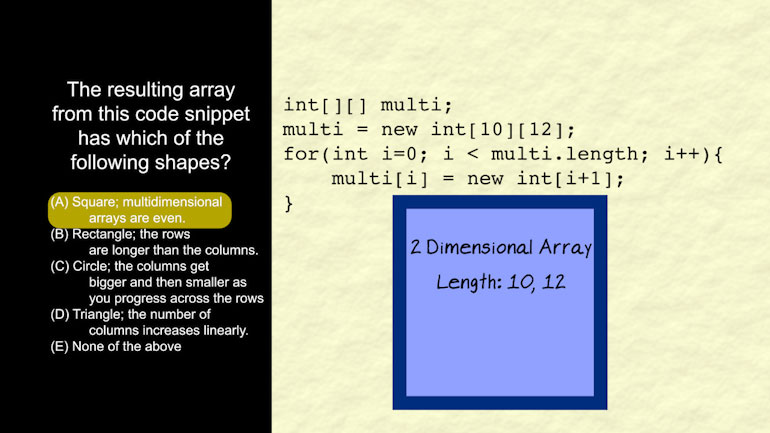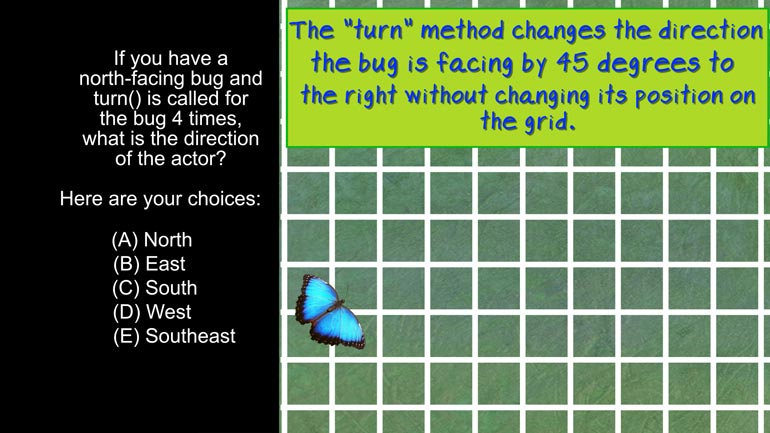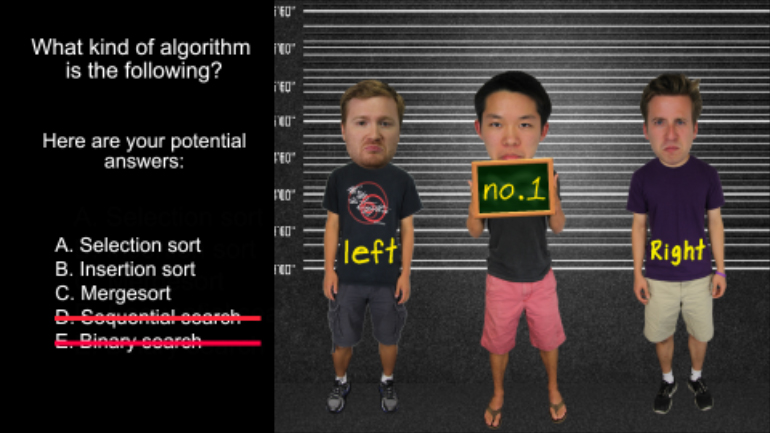ShmoopTube
Where Monty Python meets your 10th grade teacher.
Search Thousands of Shmoop Videos
Playlist AP® Computer Science: Standard Data Structures 13 videos
AP Computer Science 1.1 Standard Data Structures. Which of the following method calls will result in an error?
APCS: Standard Data Structures Drill 1, Problem 2. Which of the following methods are not appropriate for reuse in other programs?
APCS: Standard Data Structures Drill 1, Problem 3. Which of the following is the best postcondition for the fillArray method?
AP Computer Science 1.5 Standard Data Structures 174 Views
Share It!
Description:
AP Computer Science 1.5 Standard Data Structures. Which of the following is a correct iterative implementation?
Transcript
- 00:00
Thank you We sneak And here's your shmoop twos you're
- 00:05
brought to you by the power of two dirt bikes
- 00:10
now close All right which of the following is a
- 00:12
correct iterated implementations right here your potential answers And why
- 00:19
would i miss you Power raise candy bar Okay well
Full Transcript
- 00:26
there are a number of ways to populate an array
- 00:29
and the two most obvious are sequential and iterated implementations
- 00:33
Well sequential is exactly as it sounds going right down
- 00:36
the line manually giving values to each array element one
- 00:39
by one that's what's happening in answer e And because
- 00:43
we're in the market for an illiterate of solution rather
- 00:45
than sequential we can throw e out right away because
- 00:49
the values we're going to be filling the array with
- 00:52
are all mathematically related powers of two which are practically
- 00:56
blood relatives or like a really close biker gang we
- 00:59
could pretty easily is an illiterate of implementation Here We'll
- 01:03
just need a simple loop that travels down the array
- 01:05
via its indices and at each stop multiplies have value
- 01:09
by two and copies that product to the array before
- 01:12
moving on Well let's see if any of the remaining
- 01:14
loops fit the bill Option a looks good Really good
- 01:18
Luke runs without errors but it doesn't do right in
- 01:21
terms of the problem given which is to fill the
- 01:24
array with the first ten powers of two starting with
- 01:26
two So this option starts with one instead All right
- 01:30
Well in fact he has the same problem By the
- 01:34
way b is an interesting luke but makes a textbook
- 01:36
mistake on the very first line It fails to take
- 01:39
into account the old array index begins at zero thing
- 01:43
The energy er i being used as an inter reiter
- 01:46
should started zero because in a raise indexing scheme starts
- 01:50
at zero not one run This bit of code and
- 01:53
index zero would get skipped over So no good but
- 01:56
just leave c which is our answer It heroically starts
- 01:59
it's iterated zero and the first value power at two
- 02:04
While eyes less than the total length of the array
- 02:06
it'll go through loop that changes the current array element
- 02:09
to the value of power Cia network Change the value
- 02:13
of power to be itself times two and increases the
- 02:16
value of the it aerator by one and that's the
- 02:18
whole hot well
Related Videos
AP Computer Science 1.2 GridWorld Case Study and APIs. What is the direction of the actor?
AP Computer Science 1.4 Standard Algorithms. How many times will mystery be called for mystery(n) for n > 1?
AP Computer Science 2.3 Classes and Objects. Which of the following is correct implementation of the Country class?
AP Computer Science 3.4 Inheritance, Abstraction, and Polymorphism. Which of the following will satisfy the conditional if statement for boo, str,...
AP Computer Science 4.2 Standard Algorithms. What kind of algorithm is the following?
